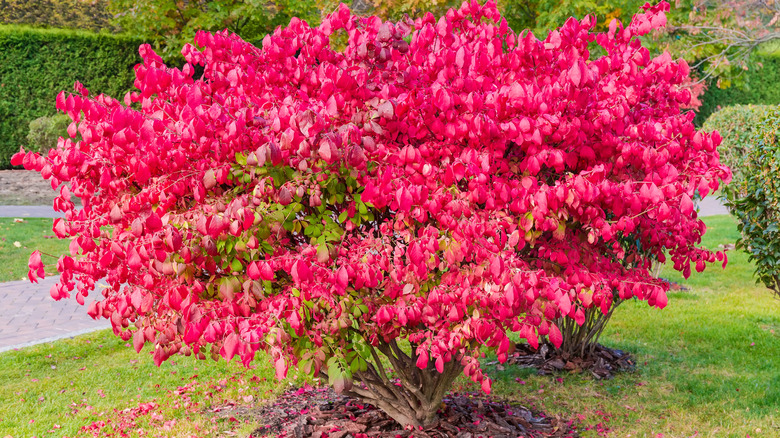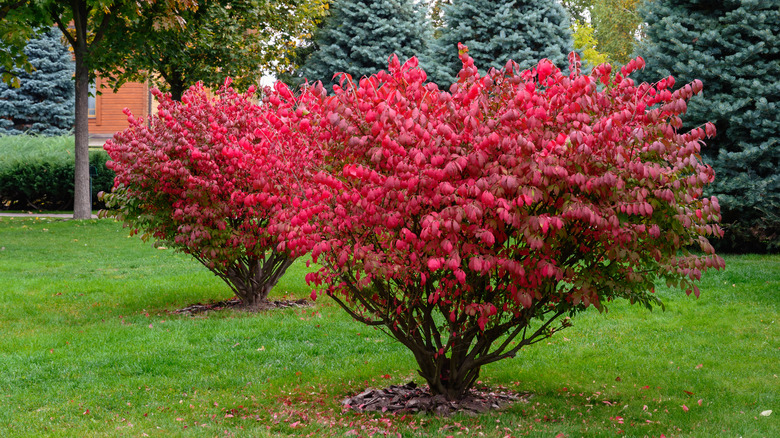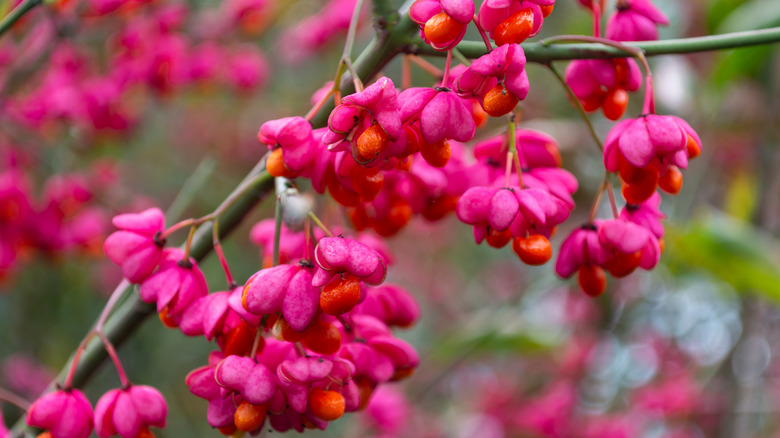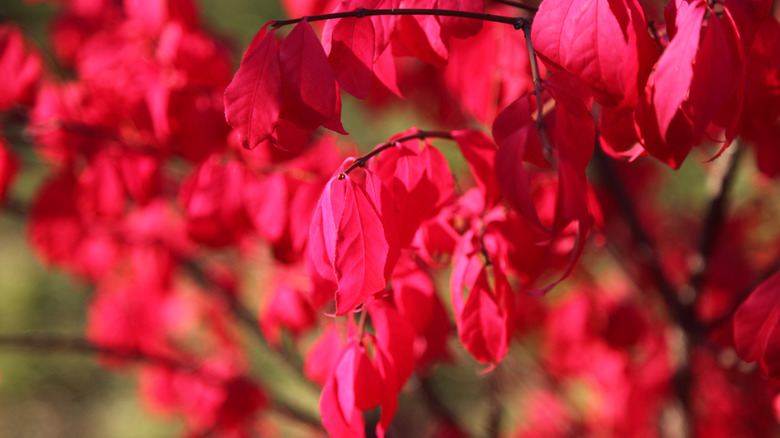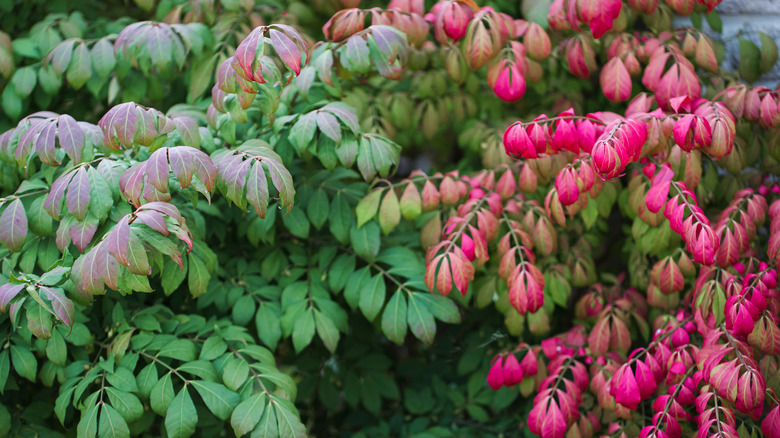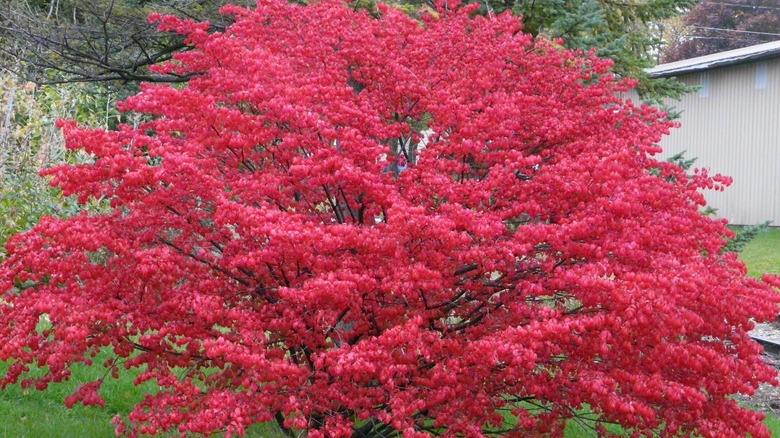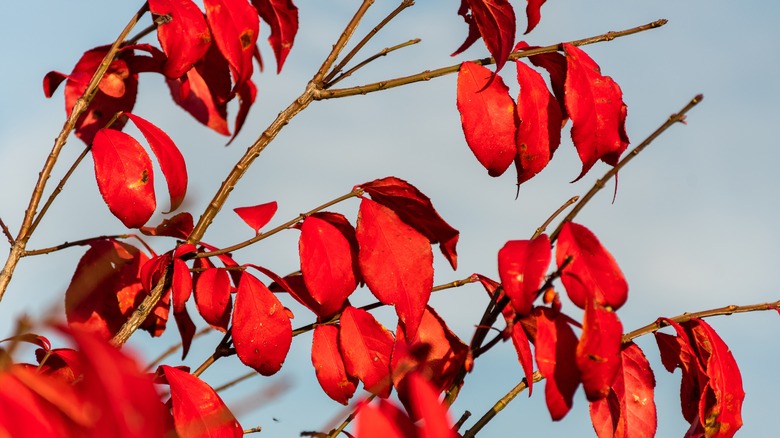How To Take Care Of A Burning Bush Plant
Commonly known as burning bush, Euonymus alatus is a staple among gardeners who look forward to admiring the bright red burst of color it adds to their gardens every fall. Native to Eastern Asia, the burning bush plant has become widely naturalized in North America; so much so that it is deemed as an invasive species in parts of the United States, per The Spruce. It is important to note that invasive species become invasive for a reason: They grow and spread quickly and easily. On that rationale, planting them is discouraged in several parts of the country, with some states even banning the sale of burning bush altogether.
Despite its invasive status in some regions, it is still a go-to in many other areas for gardening novices who appreciate its low-maintenance, easy-to-grow nature and for gardeners of all levels of expertise who simply love the crimson splendor it brings in the fall. If you do decide to plant burning bush, precautions and care should be taken to ensure the plant remains in your garden and doesn't become more of a problem than a beautiful feature in your flower bed. A burning bush plant can be a beautiful and useful addition to your garden when properly taken care of.
How to use burning bush in a garden
Some types of burning bush plants can grow to be 20 feet tall, making them a popular choice for hedges and privacy screens. According to The Spruce, burning bush plants should be given 5 to 6 feet of space when used as shrub borders and screening plants, given how quickly they spread. Even when planted as a hedge, they should still be given 2 feet of space. Giving your burning bush ample space will allow it to grow comfortably into your garden without overwhelming or overtaking the rest of your plants. There are certain dwarf varieties of burning bush that don't grow to be nearly as tall, which would be a good option for someone who likes the look of it but doesn't have the space in their garden for it.
Because of their eye-catching display of color in the fall and relatively low-maintenance growth needs, many gardeners opt to use them alone as accent plants instead. Den Garden suggests using burning bush as an accent and mixing it in among darker-colored plants, so the fiery red fall color can help add pops of color to the areas of your garden that need it the most.
How to grow burning bush
You can plant burning bush at any time of year, but the warm, moist soil of spring and autumn provide the best growing conditions, according to Gardeners' World. Though burning bush is a hearty, easy to grow plant in most conditions, it does best in full sunlight. According to The Spruce, you should plant your burning bush in an area where it can get six to eight hours of sunlight every day, though it can tolerate partial shade in warmer climates. Be aware, however, that full sun increases the splendor and brightness of the foliage in the fall, which is why many people opt to grow burning bushes in the first place.
While they can grow in most soil types, these plants do best in soil with moderate moisture and adequate drainage. Conversely, soggy soil and poor drainage are a recipe for root rot. Watering at the base of the plant as opposed to overhead is also important, as it will help prevent fungal issues on the leaves that can occur when they get too wet.
How to care for burning bush
The difficulty with burning bush is preventing it from spreading outside your garden, especially if you intend to keep it as only an accent plant. One way to prevent your burning bush from expanding out of control is to remove the berries that form on the plant before they ripen in the fall. Birds eat the berries and, in doing so, spread the seeds; the berries that are dropped by your burning bush can also form new plants, per The Spruce. Properly dispose of the berries in a bag and tie it off before disposal to prevent them from spreading.
Due to their large size and ability to spread quickly, burning bush plants require frequent pruning to be kept at a manageable size. Gardening Know How recommends pruning in the spring before the leaves appear. Not only will this cut back any overgrown branches, but it will also encourage new, healthy growth. Den Garden recommends making cuts during pruning at a 45-degree angle to allow adequate water runoff.
Burning bush varieties
The native burning bush variety can grow 20 feet tall, per The Spruce, so many variations have been bred to produce smaller, more manageable plants. If you are a low-maintenance gardener and don't foresee yourself taking the time to prune and manage your burning bush plant, you might want to consider planting one of the dwarf varieties that do not grow to be as large and do not spread as easily.
- Rudy Haag — This popular dwarf variation is considered to be slow-growing and will only reach about about 5 feet tall over the course of 15 years.
- Compactus — This is another popular dwarf variation that will grow to be around 10 feet tall over many years.
- Apterus — This variety produces plants with smooth stems rather than the distinctive ridges that appear on most types of burning bush and will grow to be about 6 feet tall.
- Monstrosus — This variety has very pronounced ridges on its stems and can grow to reach between 15 and 20 feet tall.
Is burning bush toxic?
If ingested, the leaves and berries on burning bush plants are considered toxic to humans and animals. Though no part of the plant is harmful via simple contact with the skin, Gardeners' World recommends wearing gloves while handling the plant and washing your hands afterward to avoid accidental ingestion of any plant residue. The ASPCA notes burning bush as being toxic to dogs, cats, and horses, so pet owners should exercise caution if they have a burning bush plant planted anywhere their furry friends have access. If your pet ingests any part of a burning bush plant, they may experience symptoms such as vomiting, diarrhea, abdominal pain, weakness, and heart rhythm abnormalities.
Animals often explore the world with their mouths, and a garden full of plants might tempt your pet to explore in ways they shouldn't. Always keep an eye on your pet while they are outside, especially if they have access to plants you know to be potentially harmful. Consider planting your burning bush and any other toxic plants in an area your pet does not have access to, if possible. Call your veterinarian immediately if you suspect your pet has ingested any part of a burning bush plant.
How to repot burning bush
Because of how quickly a burning bush plant fills up a container, it is almost never grown in pots, except when propagating from cuttings of a larger plant. According to The Spruce, propagating your burning bush is best done during the active growing season, which means no later than mid-summer. Using a pair of pruning shears, cut a 4- to 6-inch length of stem from your burning bush plant, ensuring the stem you cut has at least four pairs of leaves. Plant the cutting in a small pot filled with a seed-starter mix, and place the pot in a spot where it will receive indirect sunlight. The potting mix should be kept constantly moist until the roots develop, which can take several weeks.
A developed root system will cause resistance when you gently pull on the stem, which is an easy way to check on the status of your plant's root development. Once you have confirmed that the roots have developed, transplant the cutting into a larger pot filled with standard potting mix and continue growing in a sunny location. The new plant is ready to be replanted in your garden when it grows to be about a foot tall.
